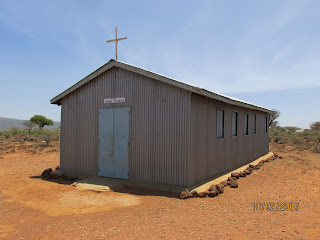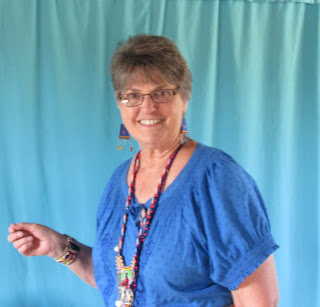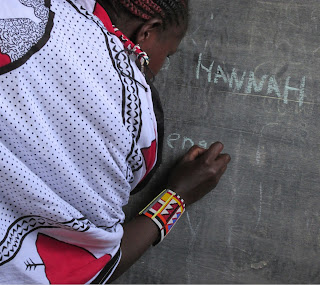Another graduation of our Adult Literacy classes! Wow. How exciting is that?!!! This one was at Ilngarooj. Don't worry if you can't pronounce it -- I can't either! I have tried and tried, but my tongue just won't cooperate. This is where the classes were held. The Pastor, James Kondonyo, and Aaron Koilel were the teachers.
The name of the church is Dominion Chapel Zion Church, Ilngarooj, Kenya.
Before any meeting in Maasai land, you will see this familiar picture -- the men sitting under the trees sipping tea.
While under another bunch of trees, the women are busy making tea and cooking lunch to feed all who come. Most of these ladies are also the students who will be graduating.
Pastor Kondonyo opening in prayer and welcoming the visitors and graduates and their families.
I look like I'm doing something, but reality is, I was teaching my Maasai friend, Peninah how to use my camera so we could record this day.
Here I am welcoming everyone as the official from Starfish Charities.
We always ask our students to demonstrate anything they have learned in the four months of literacy. All of them can write their names, do simple math, and one is even reading her Bible. I have to just give God praise for the fact that anyone can read their Bible after only four months of instruction, but it happens over and over again. These ladies (and a few men) are so eager to learn, they are exceptional students.
We always give them an official "Certificate of Completion" at the end of the classes. Pictured with us is Pastor John Shakai, one of my board members.
Here are the proud ladies who successfully completed their course. There were two men who also completed, but they weren't able to be there that day. Initially, we had 18 who registered for the class, but a severe drought afflicted the area, causing many to migrate for greener pastures -- literally. Their cows have to have grass, so they just move the herd until they find pasture. Also, affecting the ladies when drought comes, the cows quit giving milk. Most Maasai women sell milk and use it to feed their families. And with cows in their compounds, there is always plenty of manure. The ladies rake the manure into large piles to sell. Without cows, they lose a major part of their income, so they suffer. Its really a huge problem for them, so they were all rejoicing when the bountiful rains came in April, the grass started growing, and the men came home with the cows. But by then, many had missed too many classes to qualify for completion.
We always give gifts to our students and their teachers as a reward for diligence. I presented the pastor with his own Concordance! Wow. I have never seen such joy. He was thrilled.
This is our other teacher, Aaron.
The ladies are excited about their gifts!
They always wear their finest, which includes their beautiful bead work.
They also gave me gifts of beads. You will notice how many more beads I am wearing in this picture than at the beginning of this blog.
These are the additional students standing with the graduates. Although they didn't qualify to graduate on that day, they are still eager learners and want to continue the classes. Thankfully the pastor agrees. I am so blessed by their passion to learn, and by any of you who have sent funds to help make this all possible.

























































